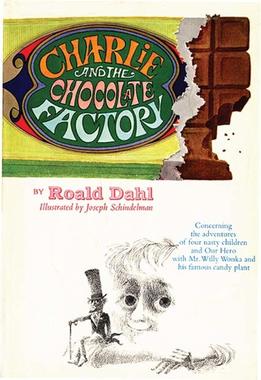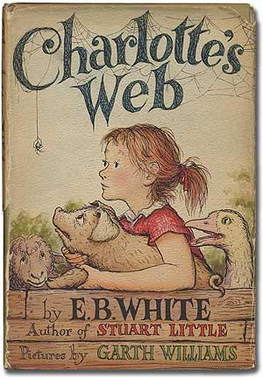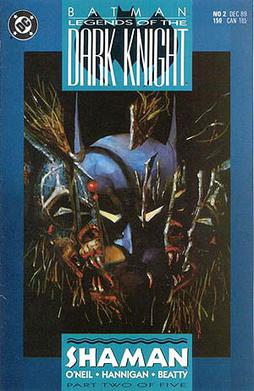
Charlie and the Chocolate Factory is a 1964 children's novel by British author Roald Dahl. The story features the adventures of young Charlie Bucket inside the chocolate factory of eccentric chocolatier Willy Wonka.

The Golden Legend is a collection of hagiographies by Jacobus de Voragine that was widely read in Europe during the Late Middle Ages. More than a thousand manuscripts of the text have survived. It was likely compiled around 1259–1266, although the text was added to over the centuries.

Charlotte's Web is a book of children's literature by American author E. B. White and illustrated by Garth Williams; it was published on October 15, 1952, by Harper & Brothers. The novel tells the story of a livestock pig named Wilbur and his friendship with a barn spider named Charlotte. When Wilbur is in danger of being slaughtered by the farmer, Charlotte writes messages praising Wilbur such as "Some Pig" and "Humble" in her web in order to persuade the farmer to let him live.

The Triforce is a fictional artifact and icon of Nintendo's The Legend of Zelda series of video games. It first appeared in the original 1986 action-adventure game The Legend of Zelda and is a focus of subsequent games in the series, including The Adventure of Link, A Link to the Past, Ocarina of Time, Oracle of Ages, Oracle of Seasons, The Wind Waker, Skyward Sword, and A Link Between Worlds. The Triforce consists of three equilateral triangles, which are joined to form a large equilateral triangle. In the fictional history of the series, it represents the essence of the Golden Goddesses named Din, Nayru and Farore who create the realm of Hyrule and is able to grant godlike power to the character who holds all three pieces. The Triforce also represents the three main characters of the series, Ganon, Zelda and Link, and their inherent qualities in the battle between good and evil. Due to its prominence and significance within the mythology of the Zelda series, the Triforce has become a widely recognisable symbol in gaming.

Princess Zelda is the titular character in Nintendo's The Legend of Zelda video game series. She was created by Shigeru Miyamoto and introduced in the original 1986 game The Legend of Zelda. She is one of the central characters in the series, having appeared in multiple incarnations over more than three decades. In the fictional storyline of the series, she is an elf-like Hylian princess of the kingdom of Hyrule, an associate of the protagonist Link, and bearer of the Triforce of Wisdom.

Wilbur Addison Smith was a Northern Rhodesian-born British-South African novelist specialising in historical fiction about international involvement in Southern Africa across four centuries.

Powers is a creator-owned comic book series written by Brian Michael Bendis and illustrated by Michael Avon Oeming. The series' first volume was published by Image Comics from 2000 to 2004, the latter moving to Marvel Comics as a part of its Icon imprint. In 2018 it moved to DC Comics as part of its Jinxworld imprint. The Jinxworld imprint moved in 2021 to Dark Horse Comics. The characters and its creators appear in Crossover.

Batman: Legends of the Dark Knight, often simply called Legends of the Dark Knight, is the name of several DC comic books featuring Batman. The original series launched in 1989 as the third major monthly Batman title, following the popularity of Tim Burton's 1989 film Batman. Many of the stories follow the tone of Frank Miller's Batman: Year One. The series differed from other Batman titles of the time. The creative team rotated with every story arc and the stories stood alone, unlike the inter-connected nature of other Batman comics. Initially the title ran stories contained to five issues, often with more mature topics and sensibilities than the other Batman titles. After issue #20, the number of issues for each story began to vary and occasionally tied into crossover events.

The Dunwich Horror is a horror novella by American writer H. P. Lovecraft. Written in 1928, it was first published in the April 1929 issue of Weird Tales (pp. 481–508). It takes place in Dunwich, a fictional town in Massachusetts. It is considered one of the core stories of the Cthulhu Mythos.

The Crow is a supernatural superhero comic book series created by James O'Barr revolving around the titular character of the same name. The series, which was originally created by O'Barr as a means of dealing with the death of his fiancée at the hands of a drunk driver, was first published by Caliber Comics in 1989. It became an underground success, and was later adapted into a film of the same name in 1994. Three film sequels, a television series, and numerous books and comic books have also been subsequently produced.
Graeme Rowland Base is a British-Australian author and artist of picture books. He is perhaps best known for his second book, Animalia published in 1986, and third book The Eleventh Hour which was released in 1989.
Opar is a fictional lost city in the Tarzan novels of Edgar Rice Burroughs and later the Khokarsa novels of Philip José Farmer and Christopher Paul Carey, as well as various derivative works in other media.
The Magician's House is a quartet of children's fantasy books by William Corlett. Two mini-series were produced in 1999 for British television, which were directed by Paul Lynch. The series featured Jennifer Saunders and Stephen Fry voicing some of the animal characters.
The Grand Comics Database (GCD) is an Internet-based project to build a database of comic book information through user contributions. The GCD project catalogues information on creator credits, story details, reprints, and other information useful to the comic book reader, comic collector, fan, and scholar. The GCD is a 501(c)(3) nonprofit organization incorporated in Arkansas.

The Eleventh Hour: A Curious Mystery is an illustrated children's book by Graeme Base. In it, Horace the Elephant holds a party for his eleventh birthday, to which he invites his ten best friends to play eleven games and share in a feast that he has prepared. However, at the time they are to eat—11:00—they are startled to find that someone has already eaten all the food. They accuse each other until, finally, they're left puzzled as to who could have eaten it all. It is left up to the reader to solve the mystery, through careful analysis of the pictures on each page and the words in the story.

Retta Scott was an American artist. She was the first woman to receive screen credit as an animator at the Walt Disney Animation Studios.

Arcadia Publishing is an American publisher of neighborhood, local, and regional history of the United States in pictorial form. Arcadia Publishing also runs the History Press, which publishes text-driven books on American history and folklore.

River God is a novel by author Wilbur Smith. It tells the story of the talented eunuch slave named Taita, his life in Egypt, the flight of Taita along with the Egyptian populace from the Hyksos invasion, and their eventual return. The novel can be grouped together with Wilbur Smith's other books on Ancient Egypt. It was first published in 1993, and was adapted for television alongside The Seventh Scroll as the 1999 mini-series The Seventh Scroll.
The Assassin's Creed series is a collection of novels by various authors, set within the fictional universe of the Assassin's Creed video game franchise created by Ubisoft. The books are set across various time periods and, like the games, revolve around the secret war fought for centuries between the Assassin Brotherhood and the Templar Order. The series includes both direct novelizations of several Assassin's Creed games, and books that function as standalone narratives, although some of these tie-in with one or more of the games in the franchise. British publishing house Penguin Books was responsible for the publication of most of the novels in the series, as well as their respective audiobook versions, until 2020, when Aconyte Books took over as the main publisher of the series.













